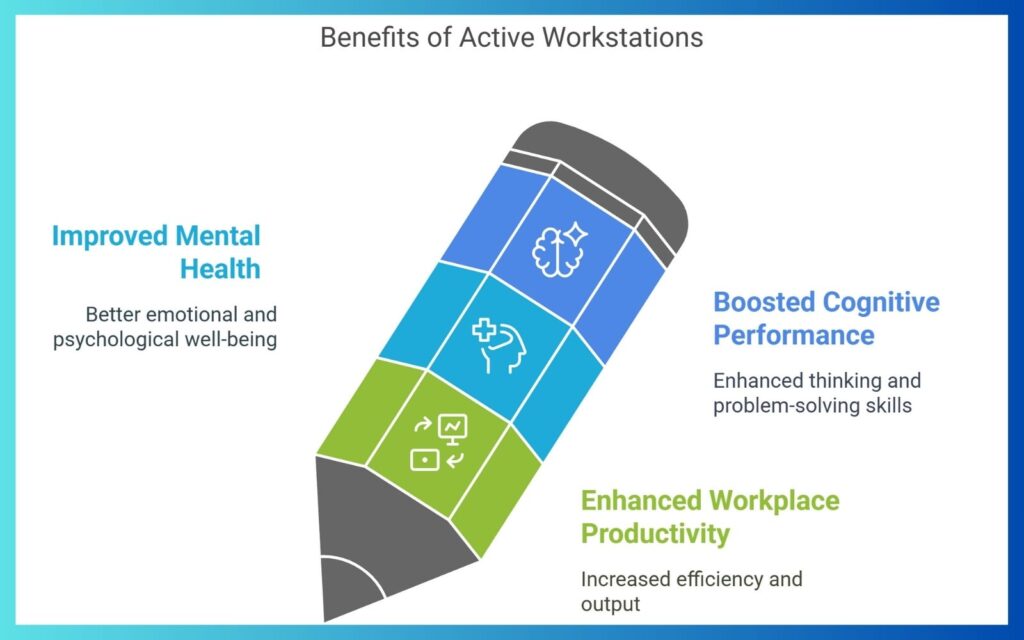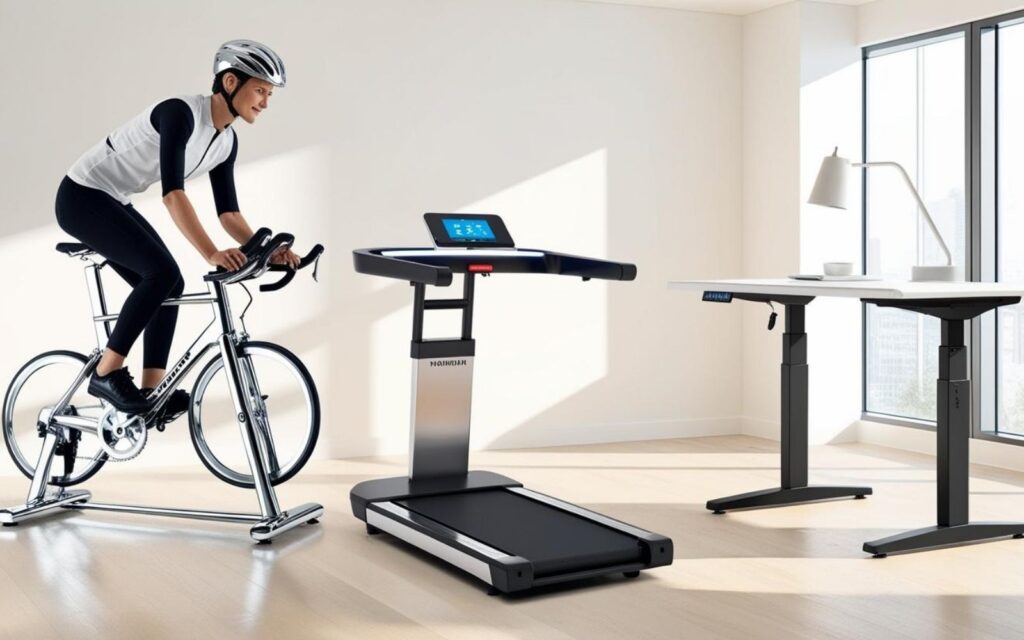Transforming Workspaces: How Active Workstations Improve Productivity

Sitting for long periods during an eight-hour workday is the reality for many office workers. But did you know that prolonged sitting is often referred to as “the new smoking” because of its impact on health and productivity?
A growing body of health research suggests that active workstations, such as standing desks, treadmill desks, and cycling workstations, can significantly improve workplace performance and overall well-being.
This article will explore how active workstations improve productivity, enhance health, and promote better workplace performance.
Whether you’re curious about treadmill workstations, standing desks, or blending movement into your work environment, this guide is for you.
Key Takeaways
- Active workstations, such as sit-stand desks and treadmill desks, can significantly improve workplace productivity.
- Prolonged sitting is linked to health risks like cardiovascular disease, obesity, and mental fatigue, but active workstations combat these issues.
- Introducing movement into office settings can enhance cognitive performance and worker productivity.
- Standing and treadmill desks improve posture and keep workers mentally sharp.
The Problem With Prolonged Sitting

Prolonged sitting dominates most office work. According to the American Heart Association, sitting for long periods contributes to obesity, cardiovascular disease, and a decline in cognitive function.
Sedentary behavior in office settings also affects workplace productivity and mental health, leaving workers feeling fatigued and stressed.
- Key Facts:
- An average office worker spends up to 75% of their day sitting.
- Sedentary time during an eight-hour workday reduces physical activity and negatively affects brain function and well-being.
- A study suggests that reducing sitting time can improve posture, prevent pain, and boost workplace performance.
How Active Workstations Improve Productivity

Active workstations, such as standing desks, treadmill desks, and cycling workstations, are designed to counteract sedentary behavior.
Here’s how they impact workplace productivity and health:
1. Boosted Cognitive Performance
Movement during the workday promotes blood circulation to the brain, enhancing cognitive performance and short-term memory.
This keeps you mentally sharp and focused.
- Study Evidence: A systematic review published in BMC Public Health found that treadmill and cycling workstations potentially improve cognitive performance while remaining productive.
2. Improved Mental Health
Active workstations reduce stress and increase endorphin levels, leading to better mental health.
Moving throughout the day makes it easier to manage workplace stress and stay positive.
3. Enhanced Workplace Productivity
Workers who incorporate movement into their day report increased task performance and creativity.
They’re also less likely to experience the mental fatigue of sitting for long periods.
- Example: Using a treadmill workstation for short intervals can help you remain productive during demanding tasks without compromising quality.
The Three Active Workstations Making a Significant Impact

1. Standing Desks
Standing desks allow you to alternate between sitting and standing, breaking up sedentary time and reducing strain on your lower back.
Sit-stand desks are widely used in office settings to blend movement into daily routines.
- Benefits:
- Encourages better posture and reduces back pain.
- Keeps energy levels steady throughout the day.
- Promotes a healthier work environment.
- Tips for Success: Start by standing for 15–30 minutes per hour, adjusting the time based on your comfort. Keep your computer screen at eye level to avoid neck strain.
2. Treadmill Workstations
Treadmill desks are a game-changer for reducing sitting time.
They combine walking and work, promoting both physical activity and cognitive function.
- Benefits:
- Increases calorie burn while keeping you focused.
- It improves cardiovascular health and reduces stress.
- Maintains performance on tasks requiring moderate mental effort.
- Potential Limitation: Research shows that typing speed may slow temporarily, but with consistent use, it balances out.
3. Cycling Workstations
Cycling workstations enable low-intensity pedaling while completing tasks.
They’re great for incorporating movement during low-focus activities like reading emails or brainstorming.
- Benefits:
- It keeps your legs active, helping to prevent stiffness.
- Promotes blood flow, boosting short-term memory and cognitive performance.
- It helps reduce sedentary behavior during long periods of office work.
- Pro Tip: Combine cycling sessions with sit-stand workstations for a balanced routine.
The Role of Health Initiatives in Office Work

Companies are increasingly adopting health initiatives to promote active workstations and reduce time spent sitting.
These initiatives aim to improve worker productivity, enhance health, and create a supportive work environment.
Why It Matters
- Systematic Reviews: Studies show that introducing sit-stand workstations into office settings improves workplace productivity and overall health.
- Preventive Cardiologist Insight: Experts recommend small but consistent movement breaks throughout the day to counteract the adverse effects of prolonged sitting.
Tips for Transitioning to Active Workstations

Switching to an active workspace doesn’t have to be overwhelming. Here are practical steps to make the transition:
- Start With Small Changes
Use sit-stand desks or stand for short intervals during tasks that don’t require intense focus. - Focus on Ergonomics
Position your computer screen and desk at the correct height to avoid strain. - Blend Movement Into Your Day
Alternate between standing, walking, and sitting to find the right balance. - Track Your Progress
Monitor your activity levels using a fitness app to stay motivated and track improvements. - Prioritize Comfort
Listen to your body – comfort is just as essential as remaining productive.
Significant Impact on Well-Being

Active workstations improve more than just productivity; they have a profound effect on overall health:
- Physical Health: Using standing and treadmill desks reduces the risks of cardiovascular disease and obesity, while also enhancing posture.
- Mental Well-being: Movement helps lower stress and makes workers feel more energized.
- Workplace Performance: Improved brain function and focus lead to better outcomes in tasks and projects.
Summary
Active workstations are transforming office settings by addressing the challenges of sedentary behavior.
By incorporating movement with standing desks, treadmill desks, and cycling workstations, office workers can boost workplace productivity, enhance cognitive function, and improve overall health.
Health research and real-world success stories demonstrate that small changes in the work environment can have a significant impact on well-being and performance.
Whether you’re looking to stay productive during an eight-hour workday or improve your posture and mental clarity, active workstations offer practical solutions for modern office work.
Frequently Asked Questions
How Do Active Workstations Improve Productivity?
Active workstations, like treadmill desks and sit-stand workstations, enhance productivity by promoting physical activity, improving brain function, and reducing stress.
Can Active Workstations Replace Traditional Desks?
Yes, active workstations are designed to be adaptable and can replace traditional desks in many office settings.
What Are the Benefits of Treadmill Workstations?
Treadmill workstations promote physical activity, enhance cardiovascular health, and help maintain focus during tasks.
Do Standing Desks Improve Workplace Performance?
Standing desks reduce sedentary time, improve posture, and keep workers mentally sharp, boosting workplace performance.
Are Active Workstations Suitable for Everyone?
Most office workers can benefit from active workstations, but adjustments may be needed based on individual preferences and tasks.





